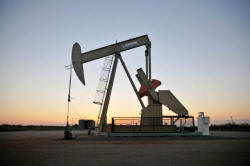Oil approaches 2015 highs on fewer U.S. rigs, OPEC
 Send a link to a friend
Send a link to a friend
 [January 08, 2018]
By Henning Gloystein and Dmitry Zhdannikov [January 08, 2018]
By Henning Gloystein and Dmitry Zhdannikov
SINGAPORE/LONDON (Reuters) - Oil prices
rose on Monday, coming close to new three-year highs on a slight decline
in the number of U.S. rigs drilling for new production and sustained
OPEC output cuts.
U.S. West Texas Intermediate (WTI) crude futures <CLc1> had risen to
$61.94 a barrel by 1140 GMT, 50 cents above their last settlement. WTI
last week reached $62.21, the highest since May 2015.
Brent crude futures <LCOc1> were at $67.95 a barrel, 33 cents above
their last close. Brent hit $68.27 last week, the highest since May
2015.
Traders said the gains were due to a slight decline in the number of
U.S. rigs drilling for new production. The rig count eased by five in
the week to Jan. 5 to 742, according to data from oil services firm
Baker Hughes.

Despite this, U.S. production <C-OUT-T-EIA> is expected soon to rise
above 10 million barrels per day, largely thanks to soaring output from
shale drillers. Only Russia and Saudi Arabia produce more.
"The U.S. oil price is now into a range that is anticipated to attract
increased shale oil production," said Ric Spooner, chief market analyst
at CMC Markets in Sydney.
"Traders may decide that discretion is the better part of valor while
markets wait on evidence of what happens to the rig count and production
levels over the next couple of months."
[to top of second column] |

A pump jack operates at
a well site leased by Devon Energy Production Company near Guthrie,
Oklahoma, U.S., September 15, 2015. REUTERS/Nick Oxford/File Photo

Rising U.S. production is the main factor countering output cuts led by the
Middle East-dominated Organization of the Petroleum Exporting Countries and by
Russia, which began in January last year and are set to last through 2018.
A senior OPEC source from a major Middle Eastern oil producer said on Monday
that OPEC was monitoring unrest in Iran as well as Venezuela's economic crisis,
but will boost output only if there are significant and sustained production
disruptions from those countries.
Stephen Innes, head of trading for Asia/Pacific at futures brokerage Oanda in
Singapore, said "the OPEC vs shale debate will rage" this year, being a key
price-driving factor.
However, Innes added that Middle East turmoil would remain a key focus for oil
markets and had the potential to "send oil prices rocketing higher".
(Reporting by Henning Gloystein, Florence Tan and Dmitry Zhdannikov; Editing by
Dale Hudson)
[© 2018 Thomson Reuters. All rights
reserved.] Copyright 2018 Reuters. All rights reserved. This material may not be published,
broadcast, rewritten or redistributed.
 |